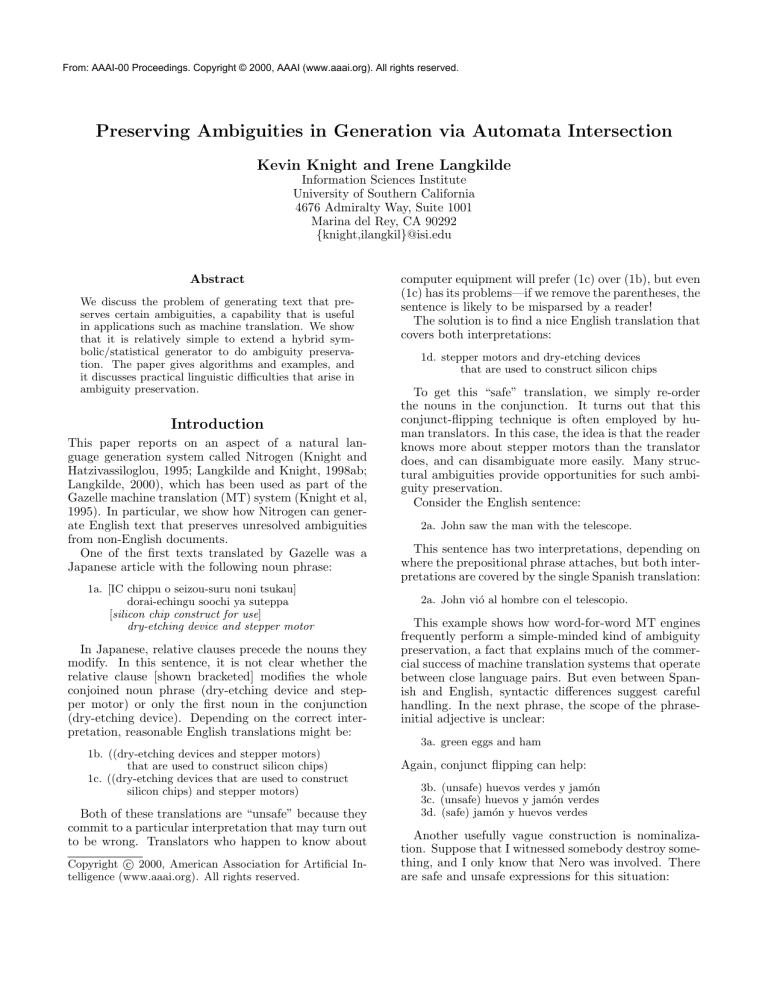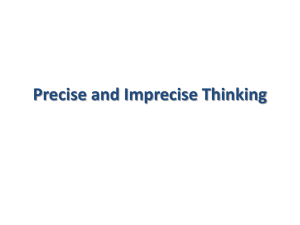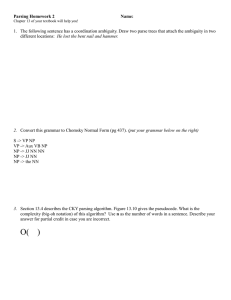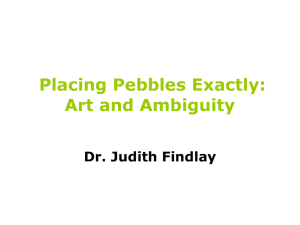Preserving Ambiguities in Generation via Automata Intersection
advertisement

From: AAAI-00 Proceedings. Copyright © 2000, AAAI (www.aaai.org). All rights reserved.
Preserving Ambiguities in Generation via Automata Intersection
Kevin Knight and Irene Langkilde
Information Sciences Institute
University of Southern California
4676 Admiralty Way, Suite 1001
Marina del Rey, CA 90292
{knight,ilangkil}@isi.edu
Abstract
We discuss the problem of generating text that preserves certain ambiguities, a capability that is useful
in applications such as machine translation. We show
that it is relatively simple to extend a hybrid symbolic/statistical generator to do ambiguity preservation. The paper gives algorithms and examples, and
it discusses practical linguistic difficulties that arise in
ambiguity preservation.
Introduction
This paper reports on an aspect of a natural language generation system called Nitrogen (Knight and
Hatzivassiloglou, 1995; Langkilde and Knight, 1998ab;
Langkilde, 2000), which has been used as part of the
Gazelle machine translation (MT) system (Knight et al,
1995). In particular, we show how Nitrogen can generate English text that preserves unresolved ambiguities
from non-English documents.
One of the first texts translated by Gazelle was a
Japanese article with the following noun phrase:
1a. [IC chippu o seizou-suru noni tsukau]
dorai-echingu soochi ya suteppa
[silicon chip construct for use]
dry-etching device and stepper motor
In Japanese, relative clauses precede the nouns they
modify. In this sentence, it is not clear whether the
relative clause [shown bracketed] modifies the whole
conjoined noun phrase (dry-etching device and stepper motor) or only the first noun in the conjunction
(dry-etching device). Depending on the correct interpretation, reasonable English translations might be:
1b. ((dry-etching devices and stepper motors)
that are used to construct silicon chips)
1c. ((dry-etching devices that are used to construct
silicon chips) and stepper motors)
Both of these translations are “unsafe” because they
commit to a particular interpretation that may turn out
to be wrong. Translators who happen to know about
c 2000, American Association for Artificial InCopyright telligence (www.aaai.org). All rights reserved.
computer equipment will prefer (1c) over (1b), but even
(1c) has its problems—if we remove the parentheses, the
sentence is likely to be misparsed by a reader!
The solution is to find a nice English translation that
covers both interpretations:
1d. stepper motors and dry-etching devices
that are used to construct silicon chips
To get this “safe” translation, we simply re-order
the nouns in the conjunction. It turns out that this
conjunct-flipping technique is often employed by human translators. In this case, the idea is that the reader
knows more about stepper motors than the translator
does, and can disambiguate more easily. Many structural ambiguities provide opportunities for such ambiguity preservation.
Consider the English sentence:
2a. John saw the man with the telescope.
This sentence has two interpretations, depending on
where the prepositional phrase attaches, but both interpretations are covered by the single Spanish translation:
2a. John vió al hombre con el telescopio.
This example shows how word-for-word MT engines
frequently perform a simple-minded kind of ambiguity
preservation, a fact that explains much of the commercial success of machine translation systems that operate
between close language pairs. But even between Spanish and English, syntactic differences suggest careful
handling. In the next phrase, the scope of the phraseinitial adjective is unclear:
3a. green eggs and ham
Again, conjunct flipping can help:
3b. (unsafe) huevos verdes y jamón
3c. (unsafe) huevos y jamón verdes
3d. (safe) jamón y huevos verdes
Another usefully vague construction is nominalization. Suppose that I witnessed somebody destroy something, and I only know that Nero was involved. There
are safe and unsafe expressions for this situation:
4a. (unsafe) I witnessed Nero being destroyed.
4b. (unsafe) I witnessed the destruction by Nero.
4c. (safe) I witnessed Nero’s destruction.
Pronoun reference can also benefit. Consider the English sentence
5. She saw the car in the window and wanted to buy it.
Although we must pick a gender for the German
equivalent of “it,” we can maintain the ambiguity if
we select translations of “car” and “window” that have
the same gender:
6a. (unsafe) Sie sah den Wagenmasc im
Schaufensterneut und wollte ihnmasc kaufen.
6b. (unsafe) Sie sah den Wagenmasc im
Schaufensterneut und wollte esneut kaufen.
6c. (safe) Sie sah das Autoneut im
Schaufensterneut und wollte esneut kaufen.
Opportunities for ambiguity preservation occur frequently, but most ambiguities cannot of course be preserved. For example, it is very difficult to preserve
lexical part-of-speech ambiguities, as in sentences like
“Time flies.” Semantic lexical ambiguities are more frequently preservable. In the English sentence “I went
to the center,” it is not clear whether “center” means
“middle” or “an institution devoted to the study of
something.” When we translate to Spanish, we can
simply say “Fui al centro,” without resolving the ambiguity.
Sometimes we can preserve an ambiguity only by appealing to awkward and disfluent constructions. Consider the following Japanese phrase:
7a. John no kuruma no kagi
John genitive-particle car genitive-particle key
There are two possible interpretations: ((John no kuruma) no kagi) and (John no (kuruma no kagi)). A
translation like “the keys of John’s car” commits to the
first interpretation, while “John’s car keys” commits to
second. In this case, it doesn’t really matter too much,
but in other cases it will. So we would like to have a
general method of preserving this kind of “X no Y no
Z” ambiguity. Fortunately, there are two constructions
that can do it—unfortunately, neither is very fluent English:
7b. (safe) the keys of the car of John
7c. (safe) John’s car’s keys
Another pitfall for ambiguity preservation is misdirection. A sentence that supposedly covers two interpretations may employ a syntactic structure that completely obscures one of them. For example, consider:
8. (supposedly safe) The CIA claimed that Jones
was a spy from 1970 to 1992.
This sentence has a single overwhelmingly strong
reading. The author of the sentence can always as-
sert to the reader that it was actually the claiming that
lasted for 1970 to 1992, not the spying, but in that case
the reader will feel that he/she has been misdirected.
To sum up, ambiguity preservation is a technique often employed by human translators, among whom it is
considered somewhat of an art. There are both opportunities and pitfalls. Ambiguity preservation is particularly interesting for machine translators, because they
are not nearly as adept as humans at resolving sourcelanguage ambiguities.
Objective
Ideally, we would like to come up with an ambiguity
preservation algorithm that is not tied to a specific
language pair or even to specific linguistic constructions. Wedekind and Kaplan (1996) consider ambiguity
preservation for generators that use LFG-style grammars. They show that the problem is undecidable: an
interesting result, but one that is of little use to the
practitioner. Emele and Dorna (1998) give an algorithm for preserving ambiguity that relies on packed
LFG f-structure representations produced by the transfer component of an MT system. Shemtov (1998) describes the ambiguity preserving version of Kay’s (1996)
chart generator. Like the above authors, we will discuss
ambiguity preservation across semantic inputs, thereby
decoupling the problem from translation. For MT applications, we allow source language analysis to generate many possible meanings which are then picked over
by an English-only generator. We also imagine nonMT applications for ambiguity preservation, for example, those that generate legal documents. Moreover, a
generator that understands how to preserve ambiguity
should also be able to steer clear of ambiguities, as again
when generating legal documents.
We contribute ambiguity-preservation algorithma
different from ones already proposed in (Shemtov, 1998;
Emele and Dorna, 1998). Our algorithm uses structures
that are somewhat simpler, and we are able to reduce
our computations to well-known, generic operations on
formal automata. Our goals are that (1) the method
we invent is simple, (2) it is efficient, (3) it is a minimal
extension to an existing generator, and (4) it is fully implemented and tested. We first describe the generator
we use and then describe our method.
Nitrogen
Nitrogen is a broad-coverage sentence realizer that generates English from conceptual expressions that include
all concepts of WordNet (Fellbaum, 1998) and a set
of sixty semantic relationships drawn from the Gazelle
MT interlingua. Because it is difficult to generate on a
scale of 100,000 words and concepts without great deal
of lexical, conceptual, and grammatical knowledge, Nitrogen supplements its shallow knowledge bases with
statistical knowledge gathered from text. The statistical knowledge also helps it build fluent sentences from
inputs that are underspecified with respect to number,
tense, definiteness, etc.
Nitrogen operates in two stages. First, a meaning
representation is transformed into a large network of
possible realizations, via an English grammar and lexicon. In the second stage, statistical knowledge is applied to select the most fluent realization.
In the first stage, it is the job of a grammar writer to
to produce all possible realizations of input structures,
i.e., particular configurations of semantic roles. This
is much easier than specifying what are all the correct
realizations in a myriad of sub-cases. The first stage of
Nitrogen therefore massively overgenerates, producing
a lot of ungrammatical and disfluent sentences. Most
of these are weeded out by the second-stage statistical
component.
Here is an example input to Nitrogen:
(p / possible,potential
:domain (o / obligatory
:domain (e / eat
:agent you
:patient chicken-meat)))
Nitrogen’s grammar produces over ten million realizations, all packed into an efficient data structure.
Here are a few randomly selected realizations:
9a. You may be obliged to eat that there was the poulet.
9b. A consumption of poulet by you may be the requirements.
9c. That the eating of chicken by you is obligatory is possible.
It is not trivial to say exactly what is wrong with such
sentences, but they are clearly bad. Of the ten million
possibilities, however, the statistical component ranks
the following reasonable sentences as its top choices for
output:
10a. You may have to eat chicken.
10b. You might have to eat chicken.
10c. You may be required to eat chicken.
We designed Nitrogen for scale, robustness, and accuracy, but it turns out that this set-up is good for
ambiguity preservation as well.
Ambiguity Preservation with Word
Lattices
The original version of Nitrogen packed its alternative
realizations into a word-lattice data structure. A small
fragment of sample Nitrogen word lattice is shown in
Figure 1. The lattice has a start state, an end state, and
transitions labeled with words. Each path corresponds
to a different sentence, and the whole lattice can be
viewed as a set of strings. Typical Nitrogen lattices have
hundreds of nodes, thousands of arcs, and billions or
more alternative sentences. To extract the most fluent
sentence, we use word-pair statistics and n-best search
procedures (Knight and Hatzivassiloglou, 1995) similar
to those used in speech recognition.
Suppose we have two possible meaning representations (derived, say, from a single Spanish input sentence):
1.
(s / see
:agent I
:patient (m / man
:possesses (t / telescope)))
-> I see the man with the telescope.
-> I see the man holding the telescope.
etc.
2.
(s / see
:agent I
:patient (m / man)
:instrument (t / telescope))
-> I see the man with the telescope.
-> With the telescope, I see the man.
etc.
Nitrogen can compute word lattices for these two
meanings independently. Sentences that express both
meanings simultaneously (i.e., preserve ambiguity) are
exactly the sentences that occur in both lattices. Here,
“I see the man with the telescope” appears in both, but
“With the telescope, I see the man” does not.
We can compute the desired sentences simply by intersecting the two lattices. There are standard “book”
algorithms for doing this. If we convert our lattices into
deterministic finite-state acceptors FSA1 and FSA2,
then Lewis and Papadimitriou (1981) give a simple algorithm that builds a new acceptor FSA3 which accepts the intersection of the strings accepted by FSA1
and FSA2. However, this algorithm is quadratic in the
number of nodes, and is not very practical on large
FSAs.
Ambiguity Preservation with Parse
Forests
The current version of Nitrogen operates somewhat differently. It packs alternative realizations into a parseforest structure.1 While a word lattice is best viewed
as a set of strings, a parse forest is best viewed as a set
of trees. Figure 2 shows three sample forests.
We first designed and implemented an algorithm for
intersecting a pair of parse forests, i.e., returning the set
of syntactic trees that appear in both forests. While
this algorithm preserves certain types of ambiguities,
e.g., by conjunct-flipping and nominalization, it fails
on others, such as the prepositional-phrase attachment
example above. In a case like “I see the man with the
1
Our main motivation is that in observing the behavior
of Nitrogen’s word-pair-based statistical ranking, we notice
many errors due to missed long-distance dependencies. We
believe that many of these errors will be corrected if we use
a syntax-based ranking, such as that of Collins (1997) or
Chelba and Jelinek (1998), operating over trees rather than
flat strings. In order to match up with statistically-collected
data, our trees are compliant with the labeling and bracketing scheme of the Penn Treebank (Marcus, Santorini, and
Marcinkiewicz, 1993). Another advantage of using forests is
that they are more compact than lattices, avoiding repetition of substructures.
chickens
required
the
chicken
obliged
poulets
an
poulet
a
to
having
be
could
be
eaten
by
you
have
might
poulets
may
poulets
poulet
chickens
poulet
chicken
required
you
chickens
obliged
chicken
eat
to
be
having
eating
be
could
poulets
the
have
might
an
may
a
poulet
chickens
chicken
Figure 1: A small fragment of a sample Nitrogen word lattice. One path represents the fluent sentence you may have
to eat chicken. Other paths correspond to less fluent or appropriate sentences. The full word lattice is many times
larger than this fragment.
S
S
PP
P
NP
NP
VB
with the telescope
saw
NN
NP
I
VP
I
DT
S
S
VP
S
VB
NP NP
NP
CC
NP
DT NN
and
DT NN
DT NN
the man
I
NP NP
VP
VB
NP NP
saw
saw
NP
the man
NP
VP
NP NP
NP NP
CC
and NP
VBG
VP
NP
CC
NP
PP
DT NN
and
DT NN
DT NN holding P
the woman
the woman
NP
DT
the woman
NN
with the telescope
VP
PP
the man
P
VBG
holding
NP
DT
NN
with the telescope
Figure 2: Three parse forests built from three semantic representations. The goal of ambiguity preservation is to
identify the trees of just those sentences which cover all meanings.
telescope,” there is no single syntactic tree that covers
both meanings. However, there are strings that cover
both meanings.
Suppose we are given parse forests PF1 and PF2.
Then we want to build a new parse forest PF3 that
includes every tree T such that either (1) T is in PF1
and T’s terminal string is in PF2, or (2) T is in PF2 and
T’s terminal string is in PF1. The following algorithm
can do this.
function preserve-ambiguity(PF1, PF2):
1. Create a lattice FSA1 that contains the same strings
as the forest PF1, using the function shown in Figure 3. (The initial call to this recursive function
should be expand-forest-into-lattice(PF1, root(PF1)).
2. Create a lattice FSA2 that contains the same strings
as the forest PF2.
3. Write down PF1 in the form of a “grammar” composed of a number of context-free rewrite rules, e.g.:
TOP → S.1
SBAR.6 → NP.9 V.10
S.1 → NP.2 VP.3
NP.9 → her
NP.2 → I
V.10 → move
VP.3 → V.4 SBAR.6 NP.5 → ADJ.7 N.8
VP.3 → V.4 NP.5
ADJ.7 → her
V.4 → saw
N.8 → move
This grammar derives only a finite number of strings.
4. Write down PF2 also using rewrite rules.
5. Compute the intersection of PF1 and FSA2. This
results in a new forest that contains all trees in PF1
whose terminal strings are in FSA2. Bar Hillel (1961)
describes an exponential-time algorithm for carrying
out this intersection. As this is impractical, we instead adopt the efficient polynomial-time formulation
described by van Noord (1995):
It can be shown that the computation of the intersection of a FSA and a CFG requires only a
minimal generalization of existing parsing algorithms. We simply replace the usual string positions with the names of the states in the FSA.
[p. 160]
Instead of using the PF1 “grammar” to parse a string,
we use it to parse the lattice FSA2. We adopt a
standard chart parser (Allen, 1989), replacing string
positions with lattice states. We process the lattice
transitions of FSA2 from left to right (in topological order), adding new constituents to the chart and
packing ambiguities in the standard way. This kind
of lattice parsing is frequently used in parsing noisy
input, as from speech recognition.
6. Compute the intersection of PF2 and FSA1.
7. Compute the union of the resulting forests (results of
steps 5 and 6) by merging their root nodes.
To preserve the three-way ambiguity of forests A, B,
and C in Figure 2, we apply the above algorithm twice,
i.e., preserve-ambiguity(preserve-ambiguity(A, B), C).
We have implemented this algorithm and integrated
it into the Nitrogen generator. When Nitrogen encounters a disjunction in its semantic input, it invokes
the ambiguity preservation routine. We have observed
this routine employing several different syntactic devices such as those we described in the first section.
***
Due to Nitrogen’s implementation there is a more efficient algorithm than the one just described for computing ambiguity-preserving trees. This algorithm is based
on two aspects of Nitrogen’s implementation. First,
Nitrogen uses a cache to store the results of mapping
sub-pieces of the input to sub-forests. The cache avoids
duplicate processing during generation because if a particular sub-piece of an input occurs in multiple inputs,
the result can retrieved from the cache rather than being regenerated. The effect of the cache is that different
forests will share sub-trees if they have sub-units of semantic representation in common. Such shared trees inherently represent an intersection between forests, and
automatically preserve ambiguity between different inputs. Unnecessary processing can be avoided by recognizing this in the ambiguity preserving algorithm,
rather than continuing to search within the shared subtree.
The second aspect of Nitrogen’s implementation that
facilitates the preservation of ambiguities is the labeling of nodes in the tree. When a sub-forest is generated, it is identified with a unique numeric label. Successive sub-forests are assigned numerically increasing
labels. A side effect of this labeling is that a partial
order on the nodes in forest is guaranteed, such that a
parent node always has a higher-numbered label than
any of its children. The ordering on the nodes can be
function expand-forest-into-lattice(forest, node)
. lat ← empty-lattice()
. for each rule r in forest with lhs(r) = symbol(node):
. . lat2 ← empty-lattice()
. . for each y in rhs(r):
. . . lat3 ← expand-forest-into-lattice(forest, y)
. . . merge-lattice-states(final-state(lat2), start-state(lat3))
. . merge-lattice-states(start-state(lat), start-state(lat2))
. . merge-lattice-states(final-state(lat), final-state(lat2))
. return(lat)
Figure 3: Expanding a forest into a lattice.
function tree-intersect (A B)
if A and B are equal then return the pair (A,B);
if there are no constituents in A or B then return nil;
if the highest node of A OR the highest node of B is a leaf node,
. then return nil;
if the highest nodes of A and B are the same then
. high-node := highest node of A;
. res1 := tree-intersect(left-of-highest(A),left-of-highest(B));
. res2 := tree-intersect(right-of-highest(A),right-of-highest(B));
. for every tree pair r1 in res1
. . for every tree pair r2 in res2
. . . A1 := append the A tree of res1 to the left of high-node
. . . . and the A tree of res2 to the right of the high node;
. . . B1 := append the B tree of res1 to the left of high-node
. . . . and the B tree of res2 to the right of the high node;
. . . add the pair (A1,B1) to the tree-pair list;
. return the tree-pair list.
if the highest node of A is greater than the highest node of B,
. for each disjunctive set S of children of A
. . A1 := substitute S for high-node in A
. . res := tree-intersect(A1,B);
. for every tree pair r in res
. . A2 := replace children in former positions of S
. . . with new parent node
. return list of tree-pairs (A2,B);
otherwise, do the previous seven steps
. reversing the roles of A and B.
Figure 4: Tree-Intersection Algorithm
used to guide the search for an intersection between
forests. Higher-numbered nodes are always expanded
first, ensuring that a shared-subtree will be discovered,
if it exists, without doing any unnecessary processing.
When a shared sub-tree is found and it is the highestnumbered node among the nodes being examined, the
divide-and-conquer method can be used to split the
remaining search into two independent sub-problems,
thereby significantly reducing the overall search space.
The algorithm in Figure 4 exploits these two aspects of Nitrogen’s implementation to achieve more efficient processing. The A and B arguments to the treeintersect function are lists of sequential nodes. Initially,
each list contains only the root node of the respective
trees being compared. The algorithm is not limited to
comparing whole forests, but equally well handles subforests and arbitrary sequences of sibling nodes. This
gives it another advantage over the previous described
algorithm since it can be integrated into the genera-
tion process, permitting the preservation of ambiguities
within inputs as well as across inputs. The algorithm
returns a list of paired trees sharing the same sequence
of words, with their differing syntactic structure preserved. This algorithm has been implemented and integrated into the Nitrogen generator.
Discussion
It was very easy to adapt Nitrogen to perform a wide
range of ambiguity preservations. Partly, this is because of the simple lattice and forest representations
it uses. Nitrogen dispenses with the feature notations
that bedevil Wedekind’s generator, Shemtov’s ambiguity preserving algorithm, and van Noord’s lattice
parser. In our experience, statistically-gathered knowledge can simulate these features fairly well, while also
taking into account the collocational properties of language that are very hard to model with features.
If an ambiguity is not preservable, we union the parse
forests instead of doing intersections. This amounts to
letting the statistical ranker choose the most fluent sentence regardless of which meaning it expresses. This
works better than expected, because strange meanings
often make for strange sentences. We do not yet address
the problems of disfluent preservations or misdirection
(examples 7 and 8), but there are promising avenues
in the Nitrogen framework. For example, we might do
both intersection and union, but assign higher weights
to trees in the intersection. These weights would multiply with those of the statistical ranker, allowing a nonpreserving fluent phrase (“John’s car keys”) to overcome a preserving disfluent one (“John’s car’s keys”).
Misdirection might be attacked by looking at the probabilities assigned to trees by a syntax-based statistical
ranker, or by examining the top n statistical parses of
proposed generator output.
We would also like to adopt a flat-structure representation for underspecified semantics and massive ambiguity packing (Copestake et al, 1995; Alshawi, 1996;
Reyle, 1996, Doerre, 1997), which has been useful to
(Shemtov, 1998; Emele and Dorna, 1998). Nitrogen’s
current meaning representation language, while allowing local disjunctions, is a straightforward but limited
feature-based one.
Acknowledgments
We gratefully acknowledge support from NSF Award
IIS-9820291.
References
Allen, J. (1989). Natural Language Understanding, Benjamin/Cummings.
Alshawi, H. (1996). Underspecified First Order Logics, in
Semantic Ambiguity and Underspecification, eds. K. van
Deemter and S. Peters.
Bar-Hillel, Y., M. Perles, and E. Shamir (1961). On Formal
Properties of Simple for a Structure Grammars, Zeitschrift
für Phonetik, SprachWissenschaft und Kommunicationsforschung, 14:143- 172, 1961. Reprinted in Language and
Information - Selected Essays on their Theory and Application, Addison Wesley series in Logic, 1964, pp. 116-150.
Chelba, C. and F. Jelinek (1998). Exploiting Syntactic
Structure for Language Modeling, Proc. COLING/ACL.
Collins, M. (1997). Three Generative, Lexicalised Models
for Statistical Parsing, Proc. ACL.
Copestake, A., D. Flickinger, R. Maloufand, S. Riehemann,
and I. Sag (1995). Translation using Minimal Recursion
Semantics, Proc. Theoretical and Methodological Issues in
Machine Translation (TMI).
Doerre, J. (1997). Efficient Construction of Underspecified
Semantics under Massive Ambiguity, Proc. ACL/EACL.
Emele, M. and M. Dorna (1998). Ambiguity Preserving
Machine Translation using Packed Representations, Proc.
COLING/ACL.
Fellbaum, C. (1998). WordNet, MIT Press. Kay, M. (1996).
Chart Generation, Proc. ACL.
Knight, K., I. Chander, M. Haines, V. Hatzivassiloglou, E.
Hovy, M. Iida, S. Luk, R. Whitney, K. Yamada (1995). Filling Knowledge Gaps in a Broad-Coverage MT System, Proc.
IJCAI.
Knight, K. and V. Hatzivassiloglou (1995). Two-Level,
Many-Paths Generation, Proc. ACL.
Langkilde, I. Forest-Based Statistical Sentence Generation,
Proc. North American ACL.
Langkilde, I. and K. Knight (1998a), The Practical Value of
N-Grams in Generation, Proc. of the International Workshop on Natural Language Generation.
Langkilde, I. and K. Knight (1998b), Generation that Exploits Corpus-Based Statistical Knowledge, Proc. COLING/ACL.
Lewis, H. and C. Papadimitriou (1981). Elements of the
Theory of Computation, Prentice-Hall, Inc.
Marcus, M., B. Santorini, and M. Marcinkiewicz (1993).
Building a Large Annotated Corpus of English: The Penn
Treebank, Computational Linguistics, 19(2).
by Composition of
Reyle, U. (1996). Co-indexing Labelled DRSs to Represent
and Reason with Ambiguities, in Semantic Ambiguity and
Underspecification, eds. K. van Deemter and S. Peters.
Shemtov, H. (1998). Ambiguity Management in Natural
Language Generation, Ph.D. thesis, Department of Linguistics, Stanford University.
van Noord, G. (1995). The Intersection of Finite State Automata and Definite Clause Grammars, Proc. ACL.
Wedekind, J. and R. Kaplan (1996). Ambiguity-Preserving
Generation with LFG- and PATR-style Grammars, Computational Linguistics, 22(4).








